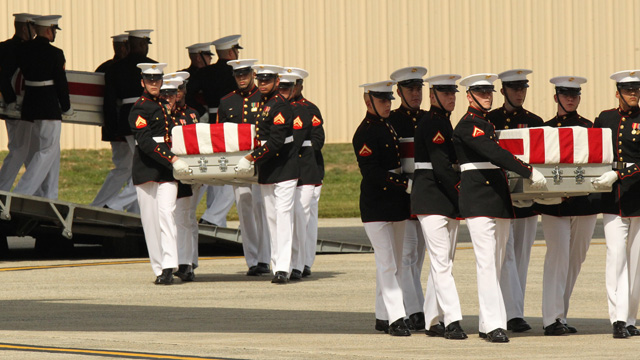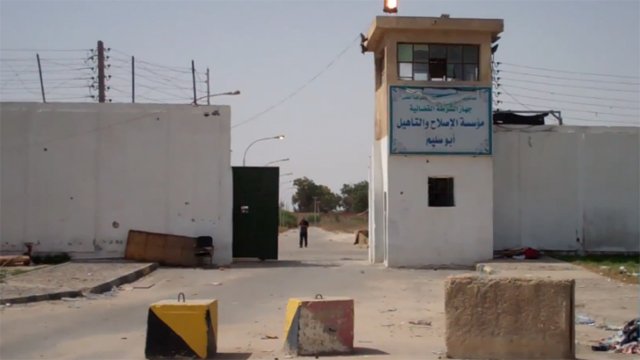
The Transfer of Remains Ceremony for the return of Ambassador Christopher Stevens and three other Libyan embassy employees. (Getty Images)
Ahmed Khattalah, the accused leader of the Libyan militia who allegedly carried out the attack on the U.S. Benghazi consulate, has been charged. The charges, which are under seal, are the first criminal counts to come out of the Benghazi probe. According to The Wall Street Journal, this is just the first of charges “against a number of suspects” in the attack.
Here are five fast facts about Ahmen Khattalah.
1. Khattalah Was Seen Participating in the Consulate Attack
Federal authorities investigating the attack on the U.S. diplomatic compound in Benghazi have filed charges against Ahmed Khattalah -CNN
— Rodrigo (@RodrigoEBR) August 6, 2013
The 41-year-old Ahmed Khattalah was seen during the Benghazi attack, according to the NY Times. Witnesses of the attack have claimed they saw him directing other fighters in Benghazi that night. Libyan officials have also singled him out.
In an interview with the NY Times, Khattalah denied being a part of the aggression and arrived as the gunfire began, but did admit to being there. He also claimed that the crowd was practicing a peaceful protest when it was coerced by consulate guards. Khattalah claims that the guards fired on the crowd first and the weapons they used were found within the consulate compound.
In a past interview with Reuters, Khattalah denied being a part of the militia, but “he was friendly with the group and knew its membership well.”
The charges under seal are the first criminal counts to emerge from the Benghazi probe, people briefed on the investigation told CNN.
— Rodrigo (@RodrigoEBR) August 6, 2013
2. Khattalah Preaches an al-Qaeda Ideology

(Getty Images)
Source have told the Benghazi probe that Khattalah propagating an al Qaeda-style ideology. Although Khattala told the NY Times that he is not a member of Al Qaeda, he said that he would be proud to be associated with their “puritanical zeal for Islamic law.”
3. Khattalah Has Been a Person of Interest Since the Benghazi Attack

(Getty Images)
The United States have been tracking Khattalah since the Benghazi consulate attack on September 11, 2012. According to reports from a month after the attack, mainstream media began reporting that the US government was working with the Libyan authorities to locate and question Khattalah.
4. Khattalah Created a Rebel Militia After Leaving Gadhafi Prison

(Image courtesy of YouTube)
Khattalah grew up in a working-class district, according to the Wall Street Journal. He began training as an auto mechanic as a teenager, before being sent to the infamous Abu Salem prison as a young adult as part of the institutionalized roundup by Gadhafi’s security police who arrested religious men deemed a threat to the former regime.
He left prison in February 2011 and started a militia with several other former prisoners to get revenge against the Gadhafi regime. Khattalah did not hold a significant role in the organization until the 2011 assassination of Abdel Fattah Younis, an interior minister in Gadhaf regime. Khattalah and his militia arrested and killed Younis, according to the Wall Street Journal.
When Gadhafi was overthrown, many of Libya’s veteral militant soldiers, some of which had fought in Afghanistan and Iraq, decided to renounce violence and chose to pursue the construction of a conservative Islamic state in Libya’s new political landscape. Khattalah refused to join the movement, according to the WSJ report, and began preaching al Qaeda-style religious views in his independent militia. He renamed the group Ansar al-Sharia, or the “Followers of Islamic Law.”
5. The Militia Was Housed in a Gadhafi-Era Police Station Before the Consulate Attack

(Getty Images)
Khattalah’s militia housed itself in a Gadhafi-era police station before the September 2012 attack on the Benghazi consulate, which resulted in the death of four Americans, including Ambassador Christopher Stevens. In line with their al-Qaeda-style religious views, Ansar al-Sharia flew a black flag, according to the Wall Street Journal, which is favored by Islamic militants instead of Libya’s revolution-era tricolor flag.